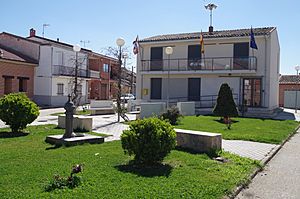Villafranca de Duero facts for kids
Quick facts for kids
Villafranca de Duero, Spain
|
|
|---|---|

Town Hall of Villafranca de Duero
|
|
| Country | Spain |
| Autonomous community | Castile and León |
| Province | Valladolid |
| Municipality | Villafranca de Duero |
| Area | |
| • Total | 10 km2 (4 sq mi) |
| Population
(2018)
|
|
| • Total | 274 |
| • Density | 27/km2 (70/sq mi) |
| Time zone | UTC+1 (CET) |
| • Summer (DST) | UTC+2 (CEST) |
Villafranca de Duero is a lovely small town located in the province of Valladolid, in the region of Castile and León, Spain. It's a place where you can experience the quiet charm of Spanish village life.
This town is known as a municipality. A municipality is like a small local area or district that has its own local government. It's a way to organize towns and villages within a larger province or region.
Contents
Where is Villafranca de Duero?
Villafranca de Duero is found in the central part of Spain. It's part of the Valladolid province, which is famous for its history and beautiful landscapes. The region of Castile and León is one of Spain's largest and has many interesting places to explore.
The town is situated near the Duero River. This river is very important for the area. It helps the land stay green and fertile.
How Many People Live Here?
According to a count done in 2018, Villafranca de Duero had about 274 people living there. This number comes from a census. A census is like a big survey that counts all the people in a country or a specific area. It helps governments understand how many people live where.
In 2004, the population was a bit higher, with 374 inhabitants. Like many small towns, the number of people living in Villafranca de Duero can change over time.
What is Life Like in Villafranca de Duero?
Life in a small Spanish town like Villafranca de Duero is often peaceful. People might know their neighbors well. The town hall, shown in the picture, is an important building. It's where local decisions are made.
The area around Villafranca de Duero is known for its "wine land." This means that grapes are grown here to make wine. This is a big part of the local economy and culture. You might see vineyards, which are fields where grapevines grow, all around the town.
See also
 In Spanish: Villafranca de Duero para niños
In Spanish: Villafranca de Duero para niños

